You probably missed this detail, but today is this blog’s first anniversary. I’ll celebrate by, well, no more than resuming its writing, after a very long break… New posts will follow every other day, no longer on a daily basis as this solution proved extremely time-consuming, and even stressing as I had to respect a deadline every evening.
Another reason for giving up this daily rate of output is the fact that I would soon run out of pictures to post. I need acceptable shots of all the various die-casts of a single car in order to prepare a new post, but lack yet pictures of most my 1/18, 1/72 and 1/87. I tackled the boring toil some months ago, only to lose several thousands of freshly-taken pictures when the hard drive of my laptop irremediably broke down. Obviously, I’m not in a hurry to do it all over again, so for the meantime I’ll have to do with what I have on hand.
Nonetheless, here is something for you all, though I shall admit more specifically aimed at those among you from across the Pyrenees. And by the way, welcome to all those who decided to follow this blog during these five months of inactivity, only to find that it was then in a state of deep coma…
A little history
Though he stopped designing aircraft following World War One, and abandoned automobile construction after going bankrupt in 1937, Gabriel Voisin never granted his prolific mind a rest until he died in 1973. After World War Two, recognizing the need for a minimal car, he introduced his C31 “Biscooter” prototype during the 1949 Paris motor show, an open four-wheeler fitted with a 200 cc Gnôme & Rhône engine. Alas, despite further development, this car would be no match for the new Citroën 2CV, as simplistic as the Voisin was, but a real automobile indeed…
This could have been the last we ever heard of Gabriel Voisin’s final automobile. Nonetheless some in Spain saw a true potential in it. The country’s relative isolation and its then-low level of development made the Biscooter an ideal car for the masses. By 1953, construction of the little car, which name had been hispanicized into “Biscuter”, started in San Adrián del Besós near Barcelona in the facilities of a newcomer, Autonacional. The powerplant initially considered had given way to a mono-cylinder Villiers of similar displacement, built under license by Hispano. With 9 hp, high performances were out of the question, but still adequate given the low weight of the car - only 240 kilograms thanks to the extensive use of aluminium. At any rate, economy was all what mattered. One drawback of the Biscuter was the absence of a reverse gear, forgotten by an all-too-simplified gearbox.
Despite its limitations the Biscuter soon became a common sight on Spanish roads, mainly due to the absence of any competitor. As most iconic automobiles, the Biscuter, rapidly nicknamed the “little shoe” (zapatilla) became equally loved and loathed. A modified transmission soon offered a reverse gear (actually, three reverse gears, no less) and new versions enlarged Autonacional’s offer: an estate in 1955, and an elegant convertible in 1957. Though much different in size and standing, the latter offered a strong similarity with the exclusive Pegaso, particularly from up front, which did not escape the eyes of the Spanish motorists who soon dubbed it the “Pegasin”.
Built by the thousand, the days of the Biscuter would nevertheless rapidly come to an end. After the uncertainty of the years immediately following the war, the standard of living was rapidly increasing in Spain, putting the cheapest Seats within reach of a growing share of the population, particularly after the release of the 600 model, in 1957. The Biscuter lingered for some more time before retiring in 1960 when its very reason to be had evaporated. Its total production is estimated from 10 to 12,000, most of the simple “zapatilla” design.
About the model
Model: Biscuter 100
Year: 1954
Maker: Ixo
Scale: 1/43
Distributed by: Altaya as no.77 of its Nos Chères Voitures d'Antan press series
Acquired: brand new, in April 2007, in Souillac, France
You probably already read some of my previous comments about how Altaya shamelessly extended its series about Fifties to Seventies French cars by throwing in some odd models which have not much to do with the subject. What to say about the Biscuter, a car exclusively built for its native Spain? Yet for a collector who likes originality this model has plenty to offer. It is rather well done, though its Andorran plates seem rather out of proportions. My rating is 12/20.
Another reason for giving up this daily rate of output is the fact that I would soon run out of pictures to post. I need acceptable shots of all the various die-casts of a single car in order to prepare a new post, but lack yet pictures of most my 1/18, 1/72 and 1/87. I tackled the boring toil some months ago, only to lose several thousands of freshly-taken pictures when the hard drive of my laptop irremediably broke down. Obviously, I’m not in a hurry to do it all over again, so for the meantime I’ll have to do with what I have on hand.
Nonetheless, here is something for you all, though I shall admit more specifically aimed at those among you from across the Pyrenees. And by the way, welcome to all those who decided to follow this blog during these five months of inactivity, only to find that it was then in a state of deep coma…
A little history
Though he stopped designing aircraft following World War One, and abandoned automobile construction after going bankrupt in 1937, Gabriel Voisin never granted his prolific mind a rest until he died in 1973. After World War Two, recognizing the need for a minimal car, he introduced his C31 “Biscooter” prototype during the 1949 Paris motor show, an open four-wheeler fitted with a 200 cc Gnôme & Rhône engine. Alas, despite further development, this car would be no match for the new Citroën 2CV, as simplistic as the Voisin was, but a real automobile indeed…
This could have been the last we ever heard of Gabriel Voisin’s final automobile. Nonetheless some in Spain saw a true potential in it. The country’s relative isolation and its then-low level of development made the Biscooter an ideal car for the masses. By 1953, construction of the little car, which name had been hispanicized into “Biscuter”, started in San Adrián del Besós near Barcelona in the facilities of a newcomer, Autonacional. The powerplant initially considered had given way to a mono-cylinder Villiers of similar displacement, built under license by Hispano. With 9 hp, high performances were out of the question, but still adequate given the low weight of the car - only 240 kilograms thanks to the extensive use of aluminium. At any rate, economy was all what mattered. One drawback of the Biscuter was the absence of a reverse gear, forgotten by an all-too-simplified gearbox.
Despite its limitations the Biscuter soon became a common sight on Spanish roads, mainly due to the absence of any competitor. As most iconic automobiles, the Biscuter, rapidly nicknamed the “little shoe” (zapatilla) became equally loved and loathed. A modified transmission soon offered a reverse gear (actually, three reverse gears, no less) and new versions enlarged Autonacional’s offer: an estate in 1955, and an elegant convertible in 1957. Though much different in size and standing, the latter offered a strong similarity with the exclusive Pegaso, particularly from up front, which did not escape the eyes of the Spanish motorists who soon dubbed it the “Pegasin”.
Built by the thousand, the days of the Biscuter would nevertheless rapidly come to an end. After the uncertainty of the years immediately following the war, the standard of living was rapidly increasing in Spain, putting the cheapest Seats within reach of a growing share of the population, particularly after the release of the 600 model, in 1957. The Biscuter lingered for some more time before retiring in 1960 when its very reason to be had evaporated. Its total production is estimated from 10 to 12,000, most of the simple “zapatilla” design.
About the model
Model: Biscuter 100
Year: 1954
Maker: Ixo
Scale: 1/43
Distributed by: Altaya as no.77 of its Nos Chères Voitures d'Antan press series
Acquired: brand new, in April 2007, in Souillac, France
You probably already read some of my previous comments about how Altaya shamelessly extended its series about Fifties to Seventies French cars by throwing in some odd models which have not much to do with the subject. What to say about the Biscuter, a car exclusively built for its native Spain? Yet for a collector who likes originality this model has plenty to offer. It is rather well done, though its Andorran plates seem rather out of proportions. My rating is 12/20.

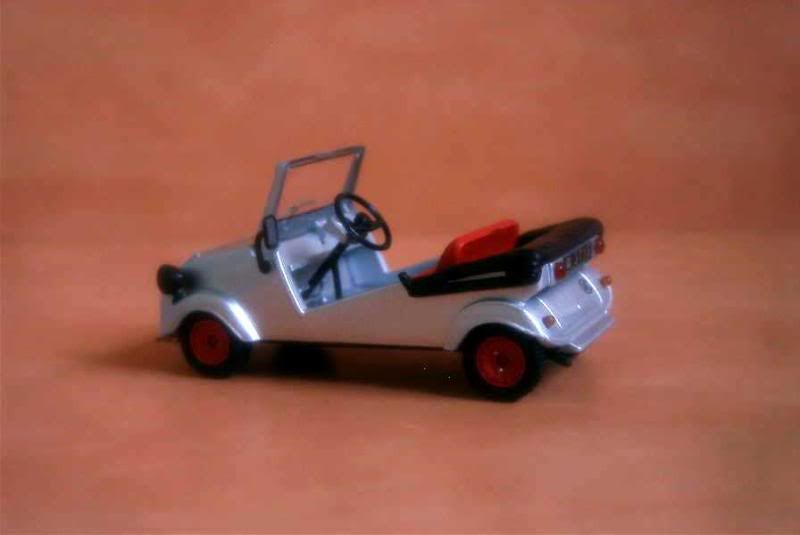
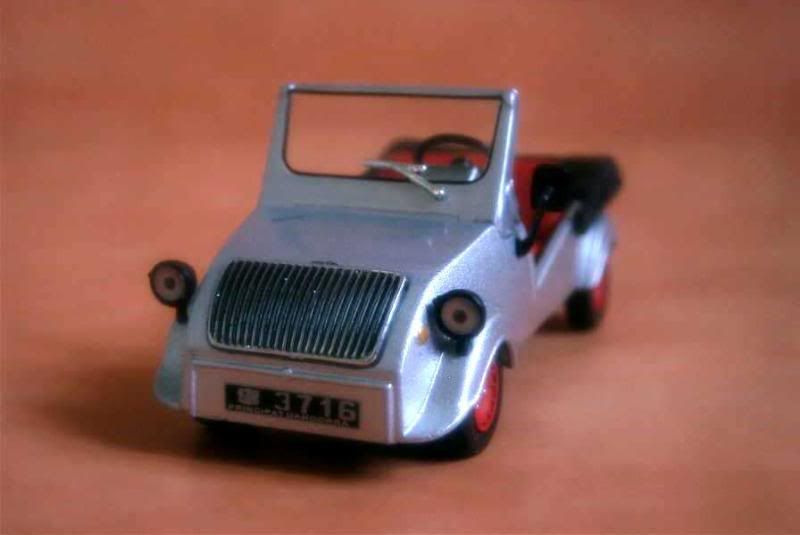
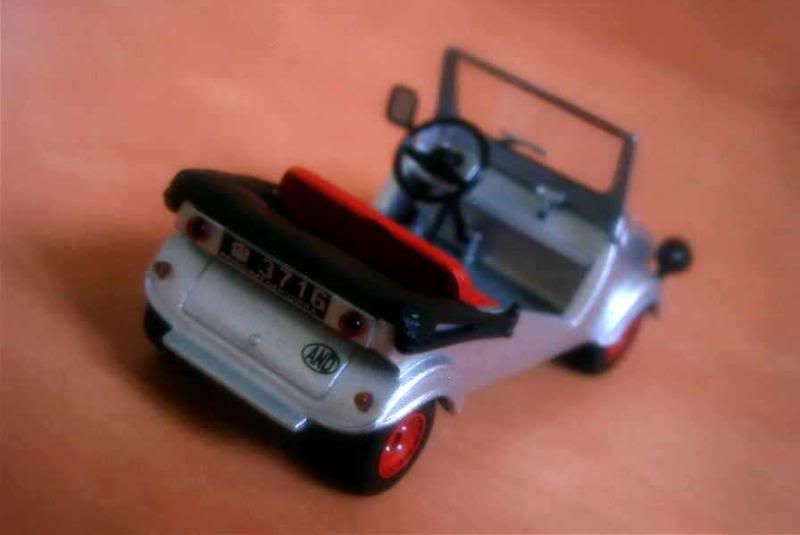
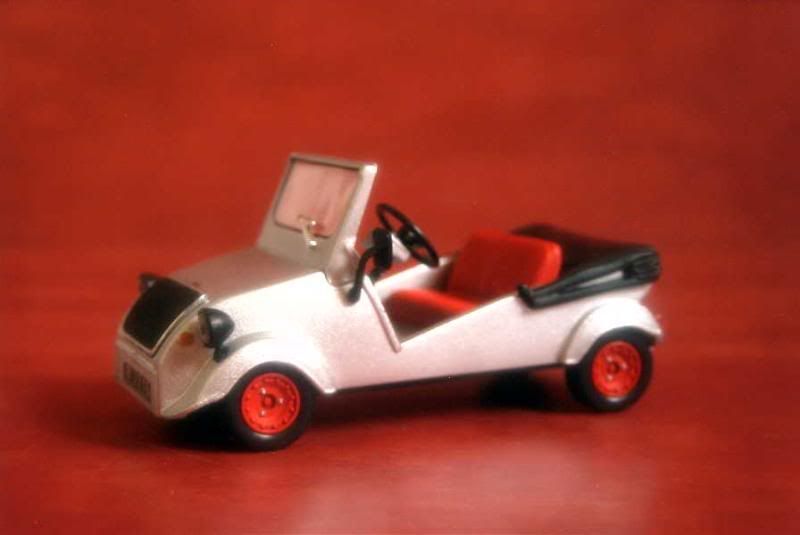
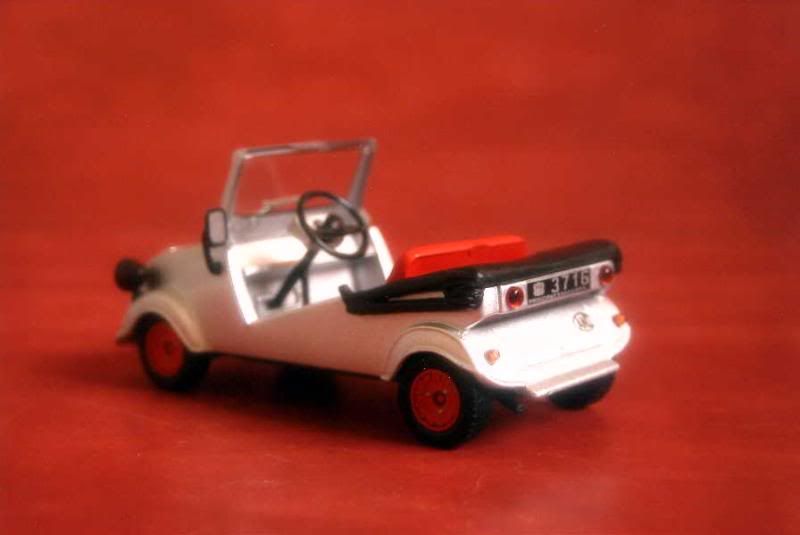



6 comments:
Welcome back, Lorenzo721!
Well, since its the blog 1st aniversary, congratulations! I hope you'll stay with us for many years with great posts!
I miss your posts. I was waiting your scale cars. Wellcome again!!
Oops, I published your posts but forgot to address them. So thanks to both of you for your warm welcome !
a milestone anniversary, /Congrats!
and that unusual model has charm!
Thanks Komenda. In my opinion that's also a departure for the usual scale Ferrari Enzo or Lamborghini Murcielago. Not that I don't appreciate those two, but I like variety on my shelves even more, so I'm happy some die-casts manufacturers reproduce models as this one.
Woops! Instead of "don't appreciate" in my previous answer, please read "appreciate" or "don't dislike".
Post a Comment